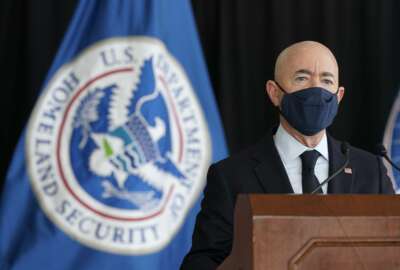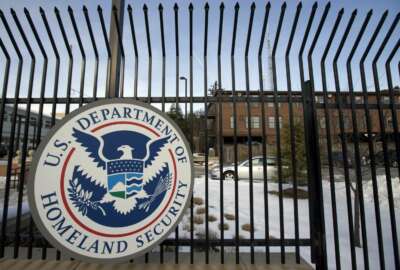Hubbard Radio Washington DC, LLC. All rights reserved. This website is not intended for users located within the European Economic Area.
DHS asks for help on maintaining wellness of its operational employees
Wellness of the workforce is a big issue for federal executives, especially for people like Border Patrol agents, who deal with stress and danger, overlaid with...
Best listening experience is on Chrome, Firefox or Safari. Subscribe to Federal Drive’s daily audio interviews on Apple Podcasts or PodcastOne.
Wellness of the workforce is a big issue for federal executives, especially for people like Border Patrol agents, who deal with stress and danger, overlaid with the pandemic. Now the Science and Technology Directorate at Homeland Security is seeking help on how to maintain a high performing and resilient workforce. The program comes under the auspices of its Silicon Valley Innovation Program. Federal Drive with Tom Temin talked about it with the managing director of the Silicon Valley Innovation Project, Melissa Oh. and the deputy director of the CBP innovation team, Jeremy Ocheltree.
Interview transcript:
Tom Temin: For what’s going on the managing director of the Silicon Valley Innovation Program, Melissa Oh. Ms. Oh, good to have you on.
Melissa Oh: Hi, Tom. Thanks for having me.
Tom Temin: And the deputy director of the CBP Innovation Team, Jeremy Ogletree. Mr. Ogletree, good to have you on.
Jeremy Ocheltree: Good to be here, Tom. Thank you.
Tom Temin: Alright, let’s maybe start with defining what is the issue here at stake for these law enforcement and operational type of people. Jeremy.
Jeremy Ocheltree: So I think the number one issue that we’re looking at trying to address here with this collaboration is this topic of the wellness of frontline employees in DHS, right. And it’s a difficult thing to quantify, for several reasons, right. Like people are obviously very, very unique. People handle physical, mental emotional stressors in very different ways. Some are better equipped than others, some understand that exercise regimen, or the diet and some of these other things that make you a little more robust toward stress, and others are just more in tune with themselves. And frankly, out of the DHS population, or law enforcement, DoD, etc., here are some folks out there that are — just they experience more stress than others, right. And so we want to get out there into this innovative community in places like Silicon Valley and Austin in Boston and the like, and see what types of innovative things might be helping are out there happening industry that we can use to address this problem.
Tom Temin: And Ms. Oh tell us just briefly about the Silicon Valley Innovation Program, and then tell us about what it is you’re seeking in the solicitation for helping on this issue of job stress and wellness?
Melissa Oh: Sure, absolutely. So the Silicon Valley Innovation Program is part of the Department of Homeland Security Science and Technology Directorate. And SVIP is really designed to make it easier for tech startups to introduce their innovative commercial technologies to DHS. As part of that we’re focused on shaping how those commercial technologies can include DHS requirements into their products, so that once they reach the commercial marketplace, DHS can more easily acquire ready made solutions. And SVIP is not just limited to Silicon Valley startups, as Jeremy mentioned, we’re looking for startups from all over the country, as well as the world. We’ve actually even funded over 60 startups from all over the world. And so specifically for this solicitation, we’re looking for those wellness tools for the DHS workforce that Jeremy mentioned, that can help employees identify and resolve those issues before it reaches crisis levels. And we felt that there was a lot of development happening in the commercial and consumer sector in this wellness space. So we want to see how best we can take advantage of those advancements and leverage technologies and adapt them for DHS use.
Tom Temin: And maybe give us just a example of the type of technology you might be seeking, maybe something you already have, so we don’t tip off the people that might be applying here. But what are some technologies that can help with the stress of work and helping people deal with it?
Melissa Oh: Sure. The three areas that we’re actually focused on is in biometric wearables, sleep recovery and enhancement, and AI enabled mobile apps. So we know that there’s a lot of development occurring by tech startups in wearables, you hear about them all the time, it’s probably on your Christmas wish list. So there’s a lot of good work being done by startups. And so say we take it, for example, wearable, and see how best that can apply to a DHS employee to help them monitor their activity levels, and hopefully provide any warning signs for them so that they can help manage their stress better. That’s just an example of how we might be able to use some commercial technologies and apply them to DHS employees.
Tom Temin: We’re speaking with Melissa Oh, she is managing director of the Silicon Valley Innovation Program at the Science and Technology Directorate at Homeland Security, and with Jeremy Ogletree, deputy director of the Customs and Border Protection innovation team. And Jeremy, what are some of the mitigating techniques in place now for law enforcement people? How do they deal with stress now, how do you help them at this point?
Jeremy Ocheltree: I think it’s equally important to understand, Melissa framed out what we’re looking for here, but it’s also important for us to frame out what we’re not looking for here. And I think in a way it answers the question, right. So I’d like to highlight the fact that DHS agencies have a significant amount of resources available to employees for a wide range of things, to include chaplaincies, we have what’s called employee assistance programs, every agency within DHS I believe has an employee assistance program or EAP, where 24/7 and employee you can call in and say, I’m dealing with X, Y, or Z issue and they can get some help. And so what we’re doing here is not in any way to replace him for that we’re not looking to replace anybody’s doctor or therapist or anything else, more than anything else we’re looking for ways to inform an individual of current, either physical, psychological or mental markers that might indicate that they’re heading towards a crisis condition and the direct impact of these resources that are already available via EAP, or their personal doctor or whatever the case may be.
Tom Temin: And Ms. Oh, then tell us about the programmatic aspects of this. Are you looking for contracts to award, are these challenge grants or what is it, you’re actually going to award once the get the entries in?
Melissa Oh: Yeah, this is a contracting opportunity. So we have funding tied to this, it is utilizing a special authority that DHS has called the other transaction authority, or OTA, it’s similar to what DoD has, and it actually allows us to contract with non traditional contractors. So in other words, companies who don’t have a track record of working with the federal government, for example, like many of the tech startups developing really innovative technologies. And we’ve designed these OTAs so that startups receive funding to adapt their products based on a milestone schedule, with four short development rounds, or phases that are about six to nine months long each. So the idea is that we’re going to get out solutions as quickly as possible with more flexible contracting, such as setup. And so the first phase that we’re looking for solutions for will be funded up to 200,000 per company. And so we’re hoping to get a number of applications addressing those three focus areas I mentioned. And hopefully, like Jeremy mentioned, we’re going to get some really exciting, interesting solutions to help our workforce.
Tom Temin: Have you surveyed, say, the Defense Department or the Veterans Affairs Department, because they have similar programs over the years developing apps and things you can consult on your phone to help you calm down, this kind of thing? Is there anything out there that might be helpful also, have you looked? Jeremy, you want to take that one?
Jeremy Ocheltree: Sure, sure, absolutely. So it’s a great question. We draw from others, and certainly did write both internally to DHS. And we did do some public or external facing engagements on this as well. But first and foremost, I’d like to highlight just the experts that we brought in internally, not only as we framed out this problem and wrote the solicitation language that eventually went out to industry, but also the types of people that we’re gonna have involved as we go forward. Because the truth of the matter is, sometimes there is in this wellness vertical, right, there’s some snake oil. And so we want stuff that’s back in science, we want stuff that has evidence, and so we brought in exercise physiologist, doctors, scientists, we brought in people from the law enforcement, community mission support, technology, experts, special operations, etc. So we’ve talked about these folks. And so via the special operations group that I mentioned before, they have ongoing relationships with several entities in the DoD, and have their finger on the pulse, no pun intended, to the types of things that the DoD specifically does for like selection courses for different special operations groups or whatever. In addition to that, we’ve had a few conversations with academia on the current state of this type of technology. So I think we have a pretty good baseline with which to deal with the industry and the stuff that comes in. So yeah, to your point, we have reached out and it’s been great interactions in both cases. And frankly, we’ve learned a great deal about the things to look out for both good and bad.
Tom Temin: Sure. And Melissa, then what is the deadlines here and when do you expect people to finish up their submissions for the solicitation?
Melissa Oh: Right, yeah. So if companies are interested and believe they have a solution for what we’re looking for, the deadlines for submission, there’s actually two application windows. The first deadline is January 13 2022, and the final deadline is April 13 2022. So we’re hoping to look for some really good solutions. We want them to check out our website, and you can just Google DHS SVIP, check out the eligibility criteria for whether or not as a company you’re eligible to apply. And we’re actually holding a virtual Industry Day on November 10 at 12:30pm, Eastern Time, where companies can hear directly from the operators that Jeremy mentioned and ask questions. They can find a link to register on our website as well.
Tom Temin: All right. Melissa Oh is managing director of the Silicon Valley Innovation Program at the Science and Technology Directorate at Homeland Security. Thanks so much for joining me.
Melissa Oh: Thank you.
Tom Temin: Jeremy. Ogletree is deputy director of the Customs and Border Protection innovation team. Thanks so much.
Jeremy Ocheltree: Thanks for having me, Tom. Really appreciate it.
Copyright © 2024 Federal News Network. All rights reserved. This website is not intended for users located within the European Economic Area.
Tom Temin
Tom Temin is host of the Federal Drive and has been providing insight on federal technology and management issues for more than 30 years.
Follow @tteminWFED





